Genre: Sports Developer: Sculptured Software Publisher: Acclaim Players: 1-2 Released: 1995
Hot off the success of its MK and Jam franchises in both arcades and consoles, Midway applied its formula of addictive, pick-up gameplay and over-the-top hijinks to the WWF universe, unleashing WrestleMania in arcades in the summer of 1995. Console versions were developed concurrently with the coin-op (a rarity back in those days) and were released mere months later in November. Porting duties were handled by Sculptured Software, which previously developed the three 16-Bit WWF games, amongst several other Acclaim releases, before being bought by the company in October of that same year. It was released (with the added subtitle of The Arcade Game to distinguish it from previous WM-themed titles) on Genesis, Super NES, 32X, PS1, Saturn and PC.
Being among the first games to be ported across concurrent console generations, several differences are to be expected. Arguably the most obscure of them all is the port for the 32X, which was in its death throes at the time, largely being overshadowed by the then-new PS1 & Saturn. Acclaim was without a doubt the most prolific U.S publisher on the 32X, supporting it until its bitter end, with WrestleMania being its last game on the console. Having been largely forgotten with the imminent death of the 32X and the availability of ports on other consoles, many missed out on what’s perhaps the best port of WrestleMania on cartridge, and an impressive showcase of the 32X’s capabilities overall.
WrestleMania: TAG (as I’ll refer to it from here on out) can be best described as Mortal Kombat meets NBA Jam meets pro wrestling. It adopts the former’s five-button system (low/high punch & kick and a block button) and violent gameplay (on a more sanitized, cartoonish scale) and the latter’s humorously impossible action, with the four-sided ring and acrobatics of pro wrestling forming the core of the gameplay. Yes, you can very much suplex, clothesline and pull off a top rope leg drop on your opponent, but since when have you seen twenty-foot choke slams and twenty+ hit combos on Monday Night RAW? Just as with Jam, you’ll find that most of the traditional rules of the sport (in this case, pro wrestling) have been thrown out the window; this is definitely more of a fighting game than a wrestling one.
The single-player mode consists of linear runs towards either the WWF Intercontinental or World Title, with the number of on-screen opponents increasing depending on mode and/or progress. It’s a Midway game, so don’t be surprised by cheap A.I tactics and beatdowns. No matter which port of the game you own, they’re all as bare-bones of an arcade port as you can get, with no additional modes or worthwhile endings, so if you’re looking for variety or replay value, you won’t find much of either here.
The game’s roster consists of circa-1994 incarnations of future legends such as The Undertaker, “The Heartbreak Kid” Shawn Michaels and Bret “Hitman” Hart, has-beens like “The Bad Guy” Razor Ramon and “Made in America” Lex Luger, and behemoths whom are sadly no longer with us such as Bam Bam Bigelow and Yokozuna, all of whom are rounded out by… Doink The Clown, resident WWF clown. Like most wrestling games (even to this day), the roster was already a bit dated by the game’s release, as Luger departed for WCW in September ’95 and Bigelow would be gone from the company by the end of that year. Moreover, the then-current WWF champion, Kevin “Diesel” Nash, was noticeably missing, despite holding the title for eleven months in 1995. Eight characters is pretty sparse for a fighting game, even back in ’95. Even previous Acclaim WWF titles had more than that. Unlike those games, however, each wrestler’s move set is unique, motivating players to try out each guy. The Undertaker launches ghouls and ghosts (not the game) at his opponents and smashes tombstones over their noggins. Doink assaults the competition with hand buzzers and mallets straight out of a Warner Brothers cartoon, while Razor Ramon slams his opponents by his feet akin to dusting out a carpet. The already cheesy personas of these wrestlers are further brought to life, with subtle (and not-so-subtle) touches that are sure to amuse both casual gamers and wrestling fans who take notice (Razor Ramon’s arms morph into saw blades and The Heartbreak Kid breaks his opponents face with a ba… oh, I get it!”)
The wrestlers and audience were further brought through life via motion-captured, digitized graphics ala Mortal Kombat, which were definitely a step-up from previous WWF titles. They were a sight to behold in the arcade and made the transition well to the 32X. Contrary to what most may believe, the 32X version of TAG isn’t just a touched-up port of the Genesis version. Not that the latter was bad; as a matter of fact, it is still one of the most impressive arcade ports for that console, faithfully reproducing the gameplay and sound effects of the coin-op at the expense of graphics and music, the latter three of which the 32X improves upon. The screen resolution was bumped up from 256X224 (Genesis) to 320X240 (32X), with the 32X hardware handling all sprites, life bars and text, while the Genesis handled in-game/demo screens and ring & audience graphics. The 32X’s wrestlers are noticeably larger and more colorful than their tiny Genesis equivalents, looking similar to the ones on the 32-Bit PS1 & Saturn ports (which themselves aren’t even as large as in the coin-op). The audience is more populated and animated than on the Genesis as well.
Still, both wrestlers and audience look grainier and less detailed in comparison to the higher-end ports, and the Genesis portions of the graphics are somewhat drab and lacking in color. Most notably, the 32X version’s frame rate was reduced to thirty FPS, compared to sixty FPS in every other version. This was most likely due to the increased resolution and in-game fireworks (with up to four large wrestlers flying and jumping across the-screen) taxing the 32X hardware which, given that it was touted as being “forty times faster than 16-Bit!” and promised “exciting 3D graphics,” must’ve disappointed those expecting more out of the console. Despite the reduced frame rate (which admittedly dips below thirty in some moments), the gameplay remains as solid as the coin-op and being on cartridge is free of the loading times which bogged down the CD-ROM versions. Overall, an impressive showing of how much on-screen stuff the 32X can handle.
The sound is pretty much built up on that of the Genesis port of TAG. The in-ring music is identical, and the 32X adds extra instruments and percussion to the already-decent Genesis renditions of the wrestler’s theme songs, giving them an extra punch. The voice samples and sound effects, which were surprisingly clear and audible on Genesis, were re-done for the 32X, sounding clearer and louder than before. In the coin-op, in-game commentary was provided by Vince McMahon and Jerry “The King” Lawler. The cartridge ports did away with what little of Lawler’s commentary there was to begin with, as well as some of McMahon’s commentary, due to space constraints.
Despite being starved of replay value, TAG is an entertaining romp that almost anybody, casual gamers, fighting game enthusiasts, wrestling fans, can pick up and enjoy. It re-invented wrestling games the same way NBA Jam revitalized video game basketball, and few, if any wrestling games (save for the vastly inferior, cash-in sequel WWF In Your House, which should be avoided at all costs!) have topped it in wackiness and over-the-top antics, favoring a more realistic style of gameplay. Then again, as of this writing, THQ is developing WWE All-Stars, a game which looks to be the modern-day, 3D equivalent of TAG. It’s even being produced by one of the main programmers behind said game (Sal DiVita, who also worked on the NBA Jam and NFL Blitz series), so keep your eyes out for that one.
The 32X port of this game is the best one on cartridge and shouldn’t be much more expensive than the Genesis version (which you could also look for as a cheaper alternative). If you’re looking for a good fighting game or overall 32X game, you can’t go wrong with WrestleMania: The Arcade Game… what, did you expect a clever, witty ending to this review? Stop rolling your eyes and, in the words of Tatsu from the first Teenage Mutant Ninja Turtles movie, “Go… Play.” *shoos you away*
SCORE: 8 out of 10

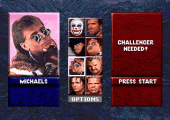
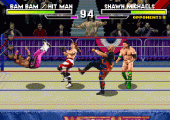
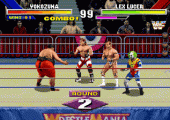
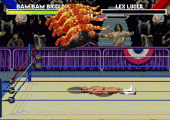
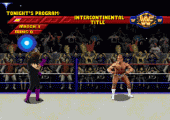
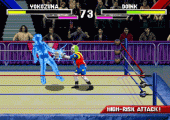
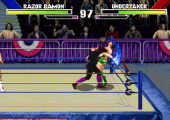
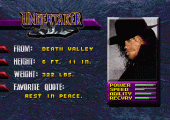

Recent Comments